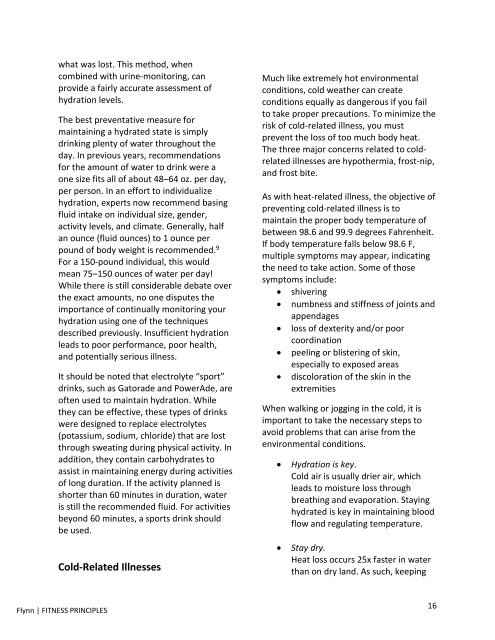Concepts of Fitness and Wellness 2e, 2018
Concepts of Fitness and Wellness 2e, 2018
Concepts of Fitness and Wellness 2e, 2018
You also want an ePaper? Increase the reach of your titles
YUMPU automatically turns print PDFs into web optimized ePapers that Google loves.
what was lost. This method, when<br />
combined with urine-monitoring, can<br />
provide a fairly accurate assessment <strong>of</strong><br />
hydration levels.<br />
The best preventative measure for<br />
maintaining a hydrated state is simply<br />
drinking plenty <strong>of</strong> water throughout the<br />
day. In previous years, recommendations<br />
for the amount <strong>of</strong> water to drink were a<br />
one size fits all <strong>of</strong> about 48–64 oz. per day,<br />
per person. In an effort to individualize<br />
hydration, experts now recommend basing<br />
fluid intake on individual size, gender,<br />
activity levels, <strong>and</strong> climate. Generally, half<br />
an ounce (fluid ounces) to 1 ounce per<br />
pound <strong>of</strong> body weight is recommended. 9<br />
For a 150-pound individual, this would<br />
mean 75–150 ounces <strong>of</strong> water per day!<br />
While there is still considerable debate over<br />
the exact amounts, no one disputes the<br />
importance <strong>of</strong> continually monitoring your<br />
hydration using one <strong>of</strong> the techniques<br />
described previously. Insufficient hydration<br />
leads to poor performance, poor health,<br />
<strong>and</strong> potentially serious illness.<br />
It should be noted that electrolyte “sport”<br />
drinks, such as Gatorade <strong>and</strong> PowerAde, are<br />
<strong>of</strong>ten used to maintain hydration. While<br />
they can be effective, these types <strong>of</strong> drinks<br />
were designed to replace electrolytes<br />
(potassium, sodium, chloride) that are lost<br />
through sweating during physical activity. In<br />
addition, they contain carbohydrates to<br />
assist in maintaining energy during activities<br />
<strong>of</strong> long duration. If the activity planned is<br />
shorter than 60 minutes in duration, water<br />
is still the recommended fluid. For activities<br />
beyond 60 minutes, a sports drink should<br />
be used.<br />
Cold-Related Illnesses<br />
Much like extremely hot environmental<br />
conditions, cold weather can create<br />
conditions equally as dangerous if you fail<br />
to take proper precautions. To minimize the<br />
risk <strong>of</strong> cold-related illness, you must<br />
prevent the loss <strong>of</strong> too much body heat.<br />
The three major concerns related to coldrelated<br />
illnesses are hypothermia, frost-nip,<br />
<strong>and</strong> frost bite.<br />
As with heat-related illness, the objective <strong>of</strong><br />
preventing cold-related illness is to<br />
maintain the proper body temperature <strong>of</strong><br />
between 98.6 <strong>and</strong> 99.9 degrees Fahrenheit.<br />
If body temperature falls below 98.6 F,<br />
multiple symptoms may appear, indicating<br />
the need to take action. Some <strong>of</strong> those<br />
symptoms include:<br />
• shivering<br />
• numbness <strong>and</strong> stiffness <strong>of</strong> joints <strong>and</strong><br />
appendages<br />
• loss <strong>of</strong> dexterity <strong>and</strong>/or poor<br />
coordination<br />
• peeling or blistering <strong>of</strong> skin,<br />
especially to exposed areas<br />
• discoloration <strong>of</strong> the skin in the<br />
extremities<br />
When walking or jogging in the cold, it is<br />
important to take the necessary steps to<br />
avoid problems that can arise from the<br />
environmental conditions.<br />
• Hydration is key.<br />
Cold air is usually drier air, which<br />
leads to moisture loss through<br />
breathing <strong>and</strong> evaporation. Staying<br />
hydrated is key in maintaining blood<br />
flow <strong>and</strong> regulating temperature.<br />
• Stay dry.<br />
Heat loss occurs 25x faster in water<br />
than on dry l<strong>and</strong>. As such, keeping<br />
Flynn | FITNESS PRINCIPLES<br />
16


















